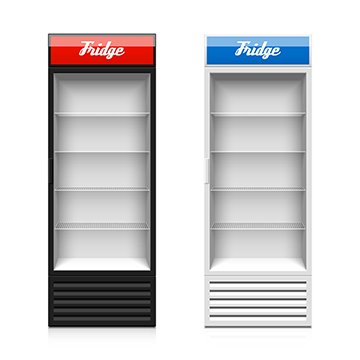Retail Food Refrigeration
Retail food refrigeration, or commercial refrigeration, includes equipment designed to store and display chilled or frozen goods for commercial sale. This end-use includes the following categories of equipment: stand-alone equipment, remote condensing units, and supermarket systems.
Categories of Equipment
Stand-alone Equipment
Stand-alone equipment includes refrigerators, freezers, and reach-in coolers (either open or with doors) where all refrigeration components are integrated and, for the smallest types, the refrigeration circuit is entirely brazed or welded. These systems are fully charged with refrigerant at the factory and typically require only an electricity supply to begin operation.
Refrigerated Food Processing and Dispensing Equipment
Refrigerated food processing and dispensing equipment dispenses and often processes a variety of food and beverage products. For instance, some such equipment will process the product by combining ingredients, mixing and preparing it at the proper temperature, while others function mainly as a holding tank to deliver the product at the desired temperature or to deliver chilled ingredients for the processing, mixing and preparation. Some may use a refrigerant in a heat pump, or utilize waste heat from the cooling system, to provide hot beverages. Some may also provide heating functions to melt or dislodge ice or for sanitation purposes.
This equipment can be self-contained or can be connected via piping to a dedicated condensing unit located elsewhere. Equipment within this end-use category include but are not limited to: chilled and frozen beverages (carbonated and uncarbonated, alcoholic and nonalcoholic); frozen custards, gelato, ice cream, Italian ice, sorbets and yogurts; milkshakes, ‘‘slushies’’ and smoothies, and whipped cream.
Remote Condensing Units
Remote condensing units have typical refrigerating capacities from 1 kW to 20 kW (0.3 to 5.7 refrigeration tons) and are composed of one (and sometimes two) compressor(s), one condenser, and one receiver assembled into a single unit, which is normally located external to the sales area. The condenser (and often other parts of the system) is located outside the space or area cooled by the evaporator, typically ejecting heat to the outdoor ambient environment. Remote condensing units are commonly installed in convenience stores, specialty shops (e.g., bakeries, butcher shops), supermarkets, restaurants, and other locations where food is stored, served or sold.
Supermarket Systems
This equipment category includes multiplex or centralized systems, which operate with racks of compressors installed in a machinery room. Two main design classifications are used: Direct and indirect systems.
In direct systems, the refrigerant circulates from the machinery room to the sales area, where it evaporates in display-case heat exchangers, and then returns in vapor phase to the suction headers of the compressor racks. Another direct supermarket design, often referred to as a distributed refrigeration system, uses an array of separate compressor racks located near the display cases rather than having a central compressor rack system.
Indirect supermarket designs include secondary loop systems and cascade refrigeration. Indirect systems use a “chiller” (not to be confused with the “chiller” end-use) or other refrigeration system to cool a secondary fluid that is then circulated throughout the store to the cases.

